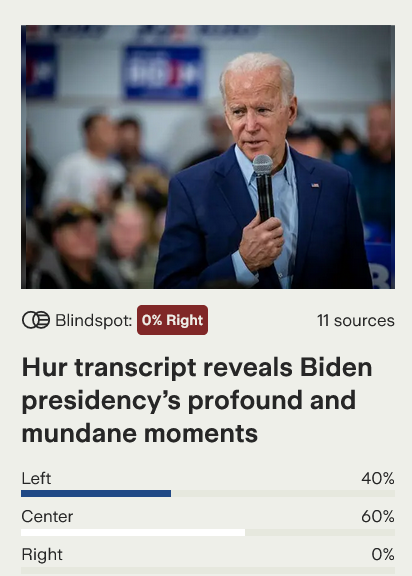When talking about censored news feeds in front of groups, I often repeat a sentence from Climate of Contempt to the effect that Democrats and liberals are more likely than Republicans and conservatives to have heard about the plot to kidnap Michigan Governor Gretchen Whitmer; Republicans and conservatives are more likely than Democrats and liberals to have heard about the plot to assassinate Supreme Court Justice Brett Kavanaugh. When I talk about this I have even heard audible reactions from audience members, who I am assuming were unaware of one or the other plot.
Censored news feeds help us develop skewed perceptions of our politics and of each other. Thanks to online algorithms and our own cognitive biases, we hear much less of the news that challenges our beliefs, and much more of the news that confirms those beliefs.
On this website I have a series of links to sites addressing media bias. They include helpful academic institutions that study the problem, as well as some of the better-known media bias and fact-checking organizations (each of which has its critics). One of the resources linked on that page is called “Blindspot.” (It is a subscription service, but they let you browse a little for free.) Blindspot tracks differences in coverage of stories by different media outlets based on the outlet’s ideology. On any given day one can log on to see evidence of how those who rely on ideological or advocacy news can miss the news the other side is seeing. (I have included four screenshots from Blindspot’s front page — all on the same day in March of this year — as part of this post.)
In my book I talk about the value of aspiring to objectivity, even if that aspiration can never be perfectly realized. Ideological news organizations have an incentive to disparage other news orgs that continue to aspire to completeness, and objectivity. For example, this Fox News discussion of media bias might have included any of the several experts listed on this website, but instead involved only a Fox host and a comedian.
It is easiest, emotionally, to focus in on how propaganda warps the thinking of others. To my fellow members of the climate coalition, the skew of right wing media seems almost ridiculously obvious; we tend not to see the skew of our preferred media sources. That is why it is important to audit our own news feeds, political social groups, and rationalizations for signs of those same dynamics at work.
A while ago CNN.com published a story about a persistently popular but false conspiracy theory: the belief that condensation trails (“contrails”) that form in the exhaust of airplanes’ jet engines are actually evidence of a government program that sprays chemicals on people (“chemtrails”). The alleged purpose of chemtrails varies by believer, but includes “to poison humanity,” or “for mind control,” or “to control the weather.”
The CNN writer explained how this unlikely conspiracy theory has gained adherents among 10-30% of people (according to surveys).
Social media’s algorithmic structure means people see information that reinforces their existing beliefs. Ex-believers interviewed attributed their ongoing belief in part to the “sheer amount of pro-conspiracy information” on their social media feeds, said Coye Cheshire, a professor at UC Berkeley … Scientific evidence debunking the theories simply wouldn’t make it onto their feeds or in their social groups. Even if it did, other believers will only reinforce the theory.
The malleable nature of the conspiracy theory helps give it strength, said Cheshire.
“As some believers told us, the power of the conspiracy is that it can be adjusted to fit any new information since the ‘smoking gun’ evidence never seems to come,” Cheshire said. “For example, even if believers are not sure that the so-called chemtrails are actually being used for population control, the narrative can easily shift to weather manipulation and climate change without requiring any new information or evidence.”
The article details the evidence debunking the theory, and the theory’s lack of supporting evidence, but (quoting an academic expert) notes that “collective agreement within these communities often overpowers the rational dissent of scientists.” This phenomenon — belief in falsehoods in online communities — is widespread.
Conspiracy theories have always been around, and scholars disagree over whether belief in them has mushroomed. But they agree that false beliefs get a boost from social media communities where our beliefs are hardened before we can fully vet them. It has led to the rapid mainstreaming of what was once the anti-vaccination fringe, the persistence of the Q-Anon conspiracy and the “stolen” 2020 election, and a generalized increase in cynicism about institutions.
For students of the energy transition who want to learn, more than they want to feed a grievance, the advice recounted in chapter 6 of Climate of Contempt is the best advice. Slow down.
Find long form news, delivered by traditional journalists, and aimed at a broad audience. Find a few stories you are willing to read in full rather than skim headlines. Process what you learn through conversation — face to face with people you know, not just in some semi-anonymous online social media community. When one’s entire political world – the information and the people in it – has been filtered to maximize our pleasure, critical thinking skills atrophy and die.
My hope is that a critical mass of voters — including those who care about U.S. liberal democracy and the politics of the energy transition — won’t let that happen. – David Spence




